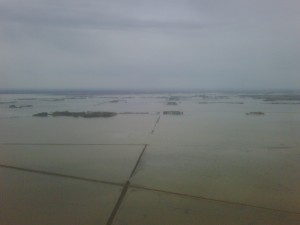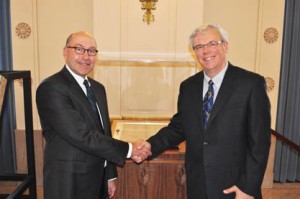The last couple of days I traveled in Manitoba and North Dakota and saw a disaster in slow motion.
Since I arrived in Canada I have spent a lot of time addressing the flooding in this part of the United States and Canada. I decided I needed to see it for myself to better understand what is going on. And what better time than as the floodwaters crested.
For anyone who has never seen this type of flooding, it is hard to describe. It brings to mind biblical times.
I saw two separate but related types of flooding.
In much of Manitoba and North Dakota there are “spring floods.” These are not like the spring floods where I come from where there are a few puddles and a basement or two gets flooded. These are towns and roads and farms disappearing. Water extending over what is usually dry land for as far as the eye can see. Seasonal flooding like this, while destructive — and this is another particularly bad year — can be prepared for. For example, the floodway in Winnipeg.
We also saw a more permanent type of flooding at Devil’s Lake which occurs because there is no natural outlet for all the water during wet cycles like the one we’re in.
We started in Winnipeg where many roads were out. But we finally made it south to Morris, Manitoba. We stood on the levy on the Morris River. I am told that during the summer you can walk across the Morris River. In summer, the bridge near where we stood is normally 20 feet above the river. What we saw today looked quite different. The bridge was submerged. There was a dike built across the road to connect the permanent levees on both sides. And there was water everywhere. Farms, houses, a cemetery, everything was under water.
We continued down Highway 75 which was down to one lane, and stopped at the border crossing at Pembina for a quick tour.
We then drove several hours south to Devil’s Lake. There was massive flooding on and off for the whole trip. But nothing we saw could prepare us for Devil’s Lake.
In the 1940′s after the drought during the Depression, Devil’s Lake was almost dry. Our tour guide remembers riding a horse across what was then open farm country and what is now water as far as the eye can see. The problem is that while water can run into Devil’s Lake, there is no natural run off. So as the rains came the lake expanded. Since the early 90′s the lake has quadrupled in size, rising more than 28 feet and inundating 138,000 acres. Miles of road have been lost, making access for school buses, supplies, and commuting difficult and time-consuming. In just this past week, the lake has risen a foot. Unlike the situation elsewhere in North Dakota and Manitoba, when the spring floods recede — which they will — Devil’s Lake won’t go down. The land is lost until the rainy periods abate (years or decades) or until we can develop some sort of a man-made solution.
Joe Belford, County Commissioner from Ramsey County, ND, took us on an extended tour around the lake. We saw hundreds of homes, tens of thousands of acres of family farms, streets, and businesses which had literally disappeared. It is heart breaking.
One scene — however — stands out in my mind. We were going through one of the many neighborhoods that were in the process of disappearing. Most of the houses were gone. A school was about to flood. (Someone asked why they would build a school so close to the lake. The answer is that when it was built it was 9 miles from the lake.) There was one house still standing with an elderly couple in the front yard raking the lawn. Joe said: “See, they aren’t giving up.” Their perseverance will — I hope — give the rest of us the inspiration to keep working until we come up with a solution to this difficult problem.
Today we drove back from Devil’s Lake and stopped at the Pembina Dike which is just on the Canadian side of the border. There is a long-standing dispute as to whether it is a road (arguably proper) or a dike to divert water (not proper). I’ll let you decide from the pictures. But I must say I didn’t see much (any) traffic.
One positive note. In Manitoba on the road north we saw huge wind farms. The commitment to alternative energy was literally an island of hope in a sea of despair.
We then drove the rest of the way back to Winnipeg where I had lunch with Manitoba Premier Greg Selinger. We had productive discussions about flooding and other issues and then went on a helicopter tour of the Winnipeg Floodway which was built to reroute part of the Red River around Winnipeg. We were told that because it spares the city from most of the flooding it has saved $30 billion since it was built.
While the city itself is dry, much of the surrounding area is not. When we headed south toward Morris and beyond we could see how the Red River — typically a few hundred yards wide — extended for MANY miles. It looked more like a huge lake than a river. It took my breath away.
I’m now on my way back to Ottawa with a much better understanding of what the people in this part of the world are enduring and with a new found energy to help try to address their problems.
DJ
















 Post Entries (RSS)
Post Entries (RSS)